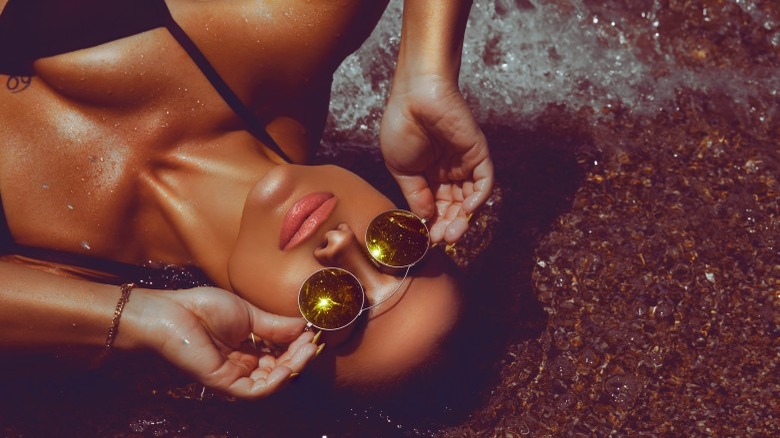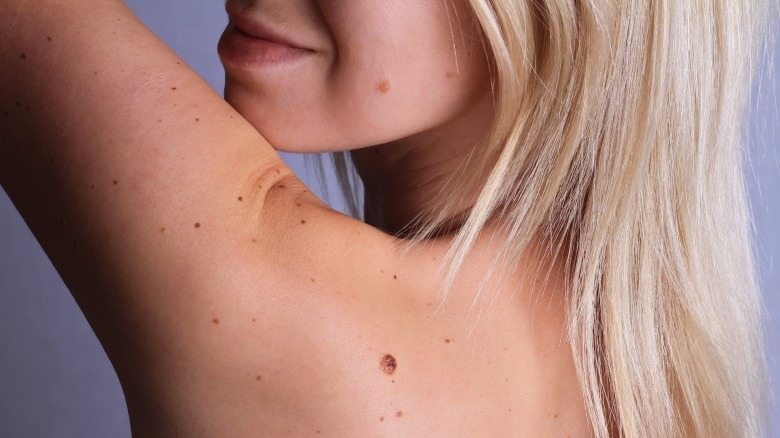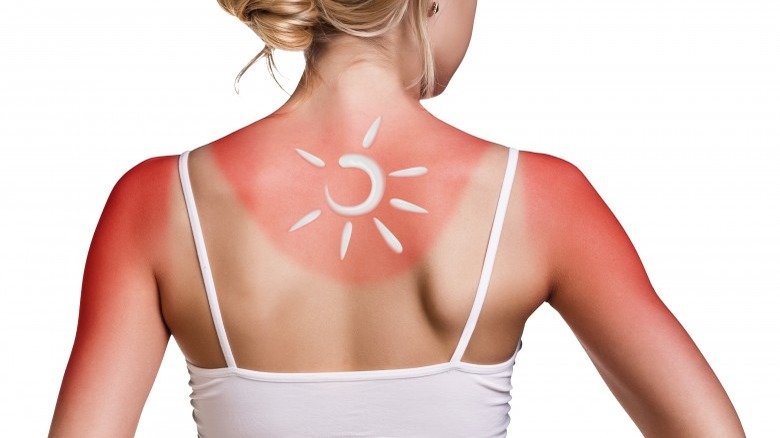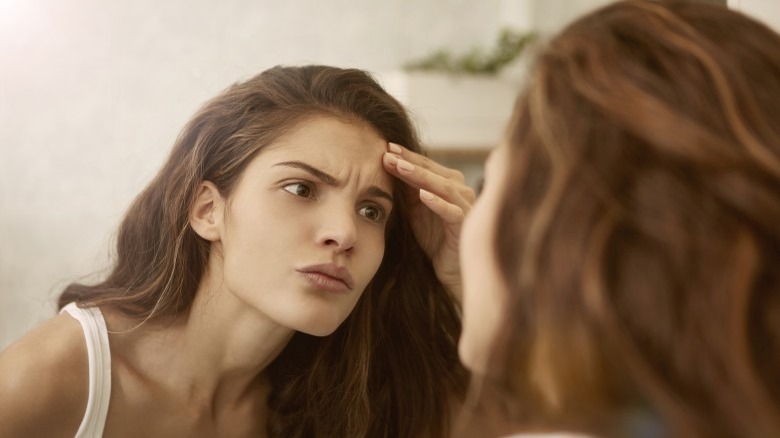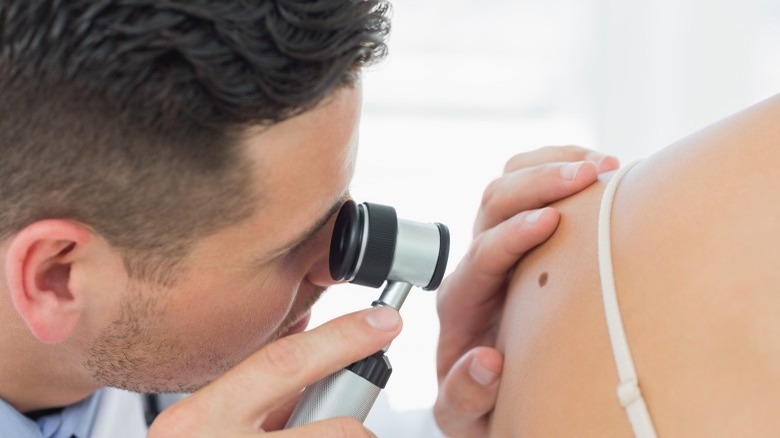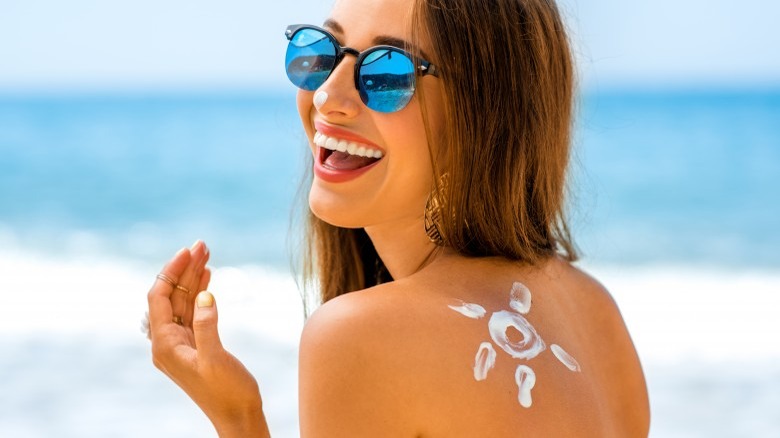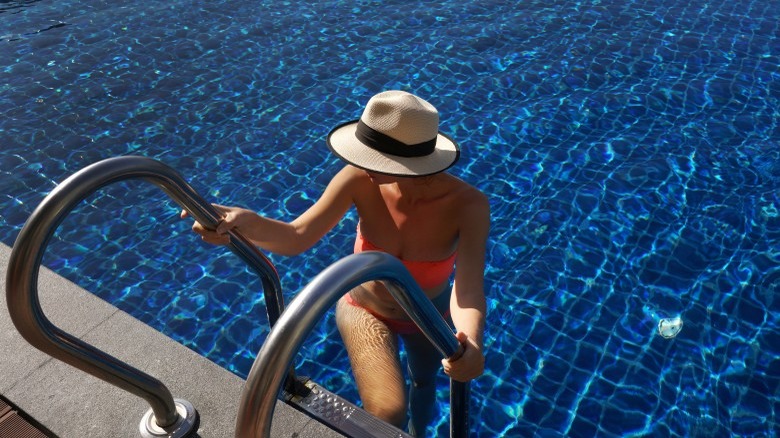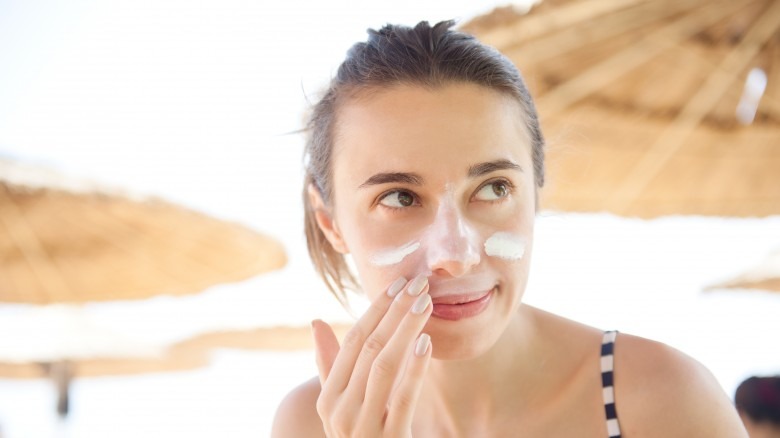What Really Happens To Your Skin When You Skip The Sunscreen
As summer approaches and the sun starts peeking out from behind the clouds, I can feel the anticipation. I love nothing more than spending the entire day outside — walking to the park, splashing at the pool, lounging on the front porch. Summer is a magical time when everything just feels a bit more relaxed.
However, there's one part about feeling that glorious sunshine on our pale faces that isn't so wonderful — those UV rays lurking everywhere you go. Sure, we all know we're supposed to wear sunscreen, but unless we're spending the entire day at the beach, most of us don't bother. "Oh I'll be inside most of the day. I never burn. I need my daily vitamin D!" Right?
A few unprotected minutes in the sun here and there don't feel like a big deal, but they add up quickly. It's time to start paying attention. Basking in the sunshine sans sunscreen leads to skin damage and skin cancer. Surprisingly, skin cancer is the most common form of cancer in the United States with more than 3.5 million cases of basal and squamous cell skin cancer diagnosed each year. Even more surprisingly, less than 10 percent of Americans actually make sure to apply sunscreen everyday. Read on to learn what really happens just below the surface when you're exposed to those dangerous rays.
You'll get a tan
Even though many of us are so over that too-tanned Jersey Shore look, we tend to like a little color. We refer to tanned skin as a sun-kissed look or a healthy glow. It's fun to come back from vacation and actually look like you went somewhere warm. Unfortunately in reality, a tan means nothing more than the start of sun damage.
Our skin is made up of three layers: epidermis, dermis, and fat. The most superficial layer, the epidermis, is responsible for protecting us from the sun. When we're exposed to the sun's UV rays (outside or in a tanning bed), our cells in the lower part of our epidermis push to the top to thicken our skin. This gives skin that tough, leathery feel. Some of the cells in this epidermis layer called melanocytes produce a darker color, giving us that tan. So that sun kissed glow actually means skin damage has already taken place.
You'll see new moles
It's common to notice more moles or freckles during the summer. The more your skin is exposed to the sun, the more spots you'll start to see. Remember those melanocyte cells that cause our skin to darken in the sun? Well, if they start to clump together, new moles develop. Fair-skinned people are more likely to develop freckles. Each of us has about 20 to 40 moles, and it's crucial to keep an eye on them. If you've noticed a new mole or one that has changed in appearance, check-in with your dermatologist to make sure it's not something more.
You'll get burned
When it comes to sun damage, a suntan is the first sign. The next is a sunburn. Sunburns are actual burns on your skin and result in hot, red, itchy areas of the skin. Depending on the severity of your burn, you may blister as well. If you tend to burn anytime you're in the sun, it's time to start lathering on the sunscreen now.
"Repeat sunburns put you at a substantial risk for skin cancer and premature skin aging," says dermatologist Jeffrey Brackeen, MD, a member of The Skin Cancer Foundation. "I want people to 'learn from the burn.'"
You'll look older
The more time you spend in the sun, the older you'll look. I've never been a fan of the wide-brimmed hats at the beach, but even I have learned to embrace them. Of course the risk of cancer sounds scary, but premature wrinkles?! You've got my attention. It's estimated that 90 percent of our skin's aging is caused by the sun. People who wear a daily sunscreen with at least SPF 15 show 24 percent less skin aging than those who go without.
In a long-term Australian study, researchers followed 900 participants for over four years. Half of the group followed their normal sunscreen routine (researchers felt it would be unethical to ask people to stop wearing it all together) and the other half was instructed to wear sunscreen everyday, no matter what. The second half also had to reapply throughout the day. At the end of the four and a half year study, the daily sunscreen group showed NO signs of skin aging. Their skin was more resilient, smoother, and less wrinkled. The other group who could use sunscreen at their own discretion showed visible signs of aging. The takeaway? If you want to keep that youthful glow, invest in some serious sunscreen and keep applying it throughout the day.
You'll put yourself at risk
The thought of cancer always feels so far away. Even as a nurse, I frequently walk outside without sunscreen. I know the risks and statistics, but as a busy, 30-something mama, cancer is pretty low on my worry list. However, it's time I change my mindset. "There is this thought that, 'It won't happen to me because I'm young,' but that's not true anymore," Dr. Jerry Brewer, a dermatologist at the Mayo Clinic told the New York Times.
Skin cancer is alarmingly common. I was shocked to learn that UV rays cause more cases of skin cancer than smoking causes cases of lung cancer. In fact, each year there are more cases of skin cancer than cancers of the breast, prostate, lung, and colon combined!
Any time spent in the sun without shade or sunscreen is putting us at risk, and you don't have to be a total sun worshiper to pay attention to this. Even just a couple sunburns in your lifetime will increase your cancer risk. So is any time in the sun okay? Not without sunscreen says Dr. Brewer. "Deciding how much sun you want to get is like asking how much cyanide you want in your breakfast cereal," Dr. Brewer told the New York Times. "There is no amount of tan that is healthy."
But I need my vitamin D!
Yes, we've all heard that we need a little sunshine to get our vitamin D fix. It's true that we need vitamin D for bone health. And yes, spending time in the sun can give us the vitamin D we need, but that doesn't give us a pass on the sunscreen. In fact, no study has ever linked wearing sunscreen with vitamin D deficiency. You don't need to put yourself at risk for cancer just to get one vitamin. Try getting it from a supplement or the food you eat. Stock up on foods rich in vitamin D like eggs and salmon. Many foods like milk and orange juice are fortified with vitamin D, so check the label.
It's also important to remember that spending just 10 to 15 minutes in the sun gives you your daily recommended amount of vitamin D. So no, you can't justify hours laying out at the pool for your vitamin health.
What if you're already burnt?
So you spent the day outside with friends and forgot the sunscreen. In addition to aging our skin and putting us at a higher risk for cancer, sunburns are also just plain uncomfortable. The trick is to treat them fast to start feeling better.
First, cool off the burning sensation. If you got burned during your pool day, take a dip in the pool to cool off your skin. Only stay in for a couple minutes, then make your way to some shade. You can also use ice packs or a cold shower if that feels good. And don't just save the cold water for the shower. Start drinking it and replace those fluids that you lost during your day in the sun. You could also try a sports drink to replace the electrolytes.
After your cold shower, break out your best lotion or moisturizing cream. Moisturize regularly to help with the peeling or blistering skin. Can't stand the pain? Try an over-the-counter anti-inflammatory medication like Ibuprofen or Aleve. You could also try a one percent cortisone cream to calm some of that sting.
How to apply sunscreen
So now that you're ready to make sunscreen part of your daily routine, make sure you're getting the most bang for your buck. First, make sure to stock up at the store. Always have some sunscreen on hand and make it part of your morning routine. Wash your face, brush your teeth, and put on sunscreen. Try buying makeup with built-in SPF to save a step.
Make sure your sunscreen protects against both UVA and UVB rays. It should have an SPF of at least 30. UVB rays are more likely to cause sunburns, but it's the UVA rays that penetrate deep into our skin, causing premature aging and skin cancer.
Next place small bottles of sunscreen wherever you might need it, like the car, your purse, or the office. Make a point to never find yourself without it. According to the Skin Cancer Foundation, no sunscreen can protect you for longer than two hours, regardless of its SPF. Keep reapplying throughout the day to stay protected.
If you're wondering if you really need the sunscreen everyday, the answer is yes. What if it's cloudy today? Or I'm not planning on being outside much? According to the American Academy of Dermatology, it doesn't matter. Just do it. When applying, use about an ounce of sunscreen (the size of your palm). So that means if you're planning a beach day with friends, each of you should be using up to one-half of an eight ounce bottle of sunscreen.
What else can I do?
Sunscreen isn't the only way you can protect yourself. "The easiest way to prevent skin cancer is to protect your skin with clothing," says board-certified dermatologist Zoe D. Draelos, MD, FAAD, consulting professor at Duke University School of Medicine. "Keep a wide-brimmed hat and sunglasses near your door so you can put them on before you go outside. Wearing a long-sleeved shirt and pants also can help protect from the damaging rays of the sun."
Once you've covered up with lightweight clothing, try to stay out of direct sunlight, especially during the hottest time of the day. Always seek shade, especially between 10 a.m. and 2 p.m.
It's also important to perform skin cancer self checks. Look for any new moles or spots. And always see your dermatologist if you're not sure. "It's critically important for people to see their board-certified dermatologist if they notice a mole or skin lesion that is changing, growing or bleeding," said Dr. Draelos. "Skin cancer can be easily treated if detected early."

